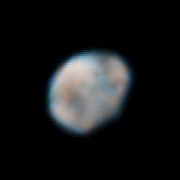
Rheasilvia
Encyclopedia

4 Vesta
Vesta, formally designated 4 Vesta, is one of the largest asteroids, with a mean diameter of about . It was discovered by Heinrich Wilhelm Olbers on March 29, 1807, and is named after the Roman virgin goddess of home and hearth, Vesta....
and is believed to be an impact crater
Impact crater
In the broadest sense, the term impact crater can be applied to any depression, natural or manmade, resulting from the high velocity impact of a projectile with a larger body...
. 460 kilometres (286 mi) in diameter, it is 80% the size of the asteroid, making it one of the largest craters in the Solar System, and covers most of the southern hemisphere. It was discovered in Hubble
Hubble Space Telescope
The Hubble Space Telescope is a space telescope that was carried into orbit by a Space Shuttle in 1990 and remains in operation. A 2.4 meter aperture telescope in low Earth orbit, Hubble's four main instruments observe in the near ultraviolet, visible, and near infrared...
images in 1997, but was not named until the arrival of the Dawn spacecraft in 2011. It is named after Rhea Silvia
Rhea Silvia
Rhea Silvia , and also known as Ilia, was the mythical mother of the twins Romulus and Remus, who founded the city of Rome...
, a mythological vestal virgin
Vestal Virgin
In ancient Roman religion, the Vestals or Vestal Virgins , were priestesses of Vesta, goddess of the hearth. The College of the Vestals and its well-being was regarded as fundamental to the continuance and security of Rome, as embodied by their cultivation of the sacred fire that could not be...
and mother of the founders of Rome.
Rheasilvia has an escarpment along part of its perimeter which rises 4–12 km above the surrounding terrain. The crater floor lies about 13 kilometres (8 mi) below the surrounding surface. This basin consists of undulating terrain and a central mound, almost 200 kilometres (124 mi) in diameter, which rises 23 kilometres (14 mi) from its base, one of the tallest mountains in the Solar System. Spectroscopic
Spectroscopy
Spectroscopy is the study of the interaction between matter and radiated energy. Historically, spectroscopy originated through the study of visible light dispersed according to its wavelength, e.g., by a prism. Later the concept was expanded greatly to comprise any interaction with radiative...
analyses of Hubble images have shown that this crater has penetrated deep through several distinct layers of the crust, and possibly into the mantle
Mantle (geology)
The mantle is a part of a terrestrial planet or other rocky body large enough to have differentiation by density. The interior of the Earth, similar to the other terrestrial planets, is chemically divided into layers. The mantle is a highly viscous layer between the crust and the outer core....
, as indicated by spectral signatures of olivine
Olivine
The mineral olivine is a magnesium iron silicate with the formula 2SiO4. It is a common mineral in the Earth's subsurface but weathers quickly on the surface....
.
Vesta has a series of grooves in in equatorial region running parallel to the rim of Rheasilvia. These are believed to be compression fractures from the impact. There is expected to be impact-related topography at the antipodes as well, but this will not be known until the north pole becomes visible at the end of the northern winter.
It is estimated that the impact responsible excavated about 1% of the volume of Vesta, and it is likely that the Vesta family
Vesta family
The Vesta or Vestian family of asteroids is a large and prominent grouping of mostly V-type asteroids in the inner asteroid belt in the vicinity of 4 Vesta...
and V-type asteroid
V-type asteroid
The spectra of the V-type asteroids or Vestoids are similar to that of 4 Vesta, by far the largest asteroid in this class ....
s are the products of this collision. If this is the case, then the fact that 10-km fragments have survived bombardment until the present indicates that the crater is at most about 1 billion years old. It would also be the origin of the HED meteorite
HED meteorite
HED meteorites are a subgroup of achondrite meteorites. HED stands for "Howardite–Eucrite–Diogenite".These achondrites came from a differentiated parent body and experienced extensive igneous processing not much different from the magmatic rocks found on Earth and for this reason they closely...
s. Known V-type asteroids account for 6% of the ejected volume, with the rest of the fragments presumably either too small to observe, or removed from the asteroid belt by approaching the 3:1 Kirkwood gap
Kirkwood gap
A Kirkwood gap is a gap or dip in the distribution of main-belt asteroids with semi-major axis , as seen in the histogram below...
, by the Yarkovsky effect
Yarkovsky effect
The Yarkovsky effect is a force acting on a rotating body in space caused by the anisotropic emission of thermal photons, which carry momentum...
, or (in the case of small fragments) by radiation pressure
Radiation pressure
Radiation pressure is the pressure exerted upon any surface exposed to electromagnetic radiation. If absorbed, the pressure is the power flux density divided by the speed of light...
.

